In episode 3 of "Simon & Greg Record the World," the intrepid recordists took their portable rig to several locations in Senegal. In this excerpt, they set up at the home of Papice, the lead singer from the band Casavoice. The prime reason for choosing his house for the recording was that it was at the outskirts of town and therefore in a quieter area where outside noise would be less of an issue.
Simon & Greg chose the living room at Papice's house for tracking, remarking that it reminded them of the room used for recording the classic Cuban album, "Buena Vista Social Club."
If you haven't heard about it yet, Pruemix is running a Simon & Greg mixing contest, where you get a chance to mix one of the songs they recorded on their journey. The deadline is 11:59pm EDT September 24th, 2019.
In-House Recording
Casavoice consists of a lead vocalist/acoustic guitarist, a hand drummer/vocalist playing what appear to be djembes—and a percussionist/vocalist playing a small, shaker-like hand percussion instrument. The challenge for Simon & Greg was how to record this ensemble live in the same room, while getting the best sounds they could, with as much separation as possible between the various parts.
They moved the existing, upholstered furniture in the room to surround Papice and create some isolation from the other musicians. For recording his acoustic guitar, they chose a Sennheiser 421 dynamic mic and a DI. For his voice, they used their best quality mic, a Lauten Audio Atlantis FC-387, which is a large-diaphragm FET condenser.
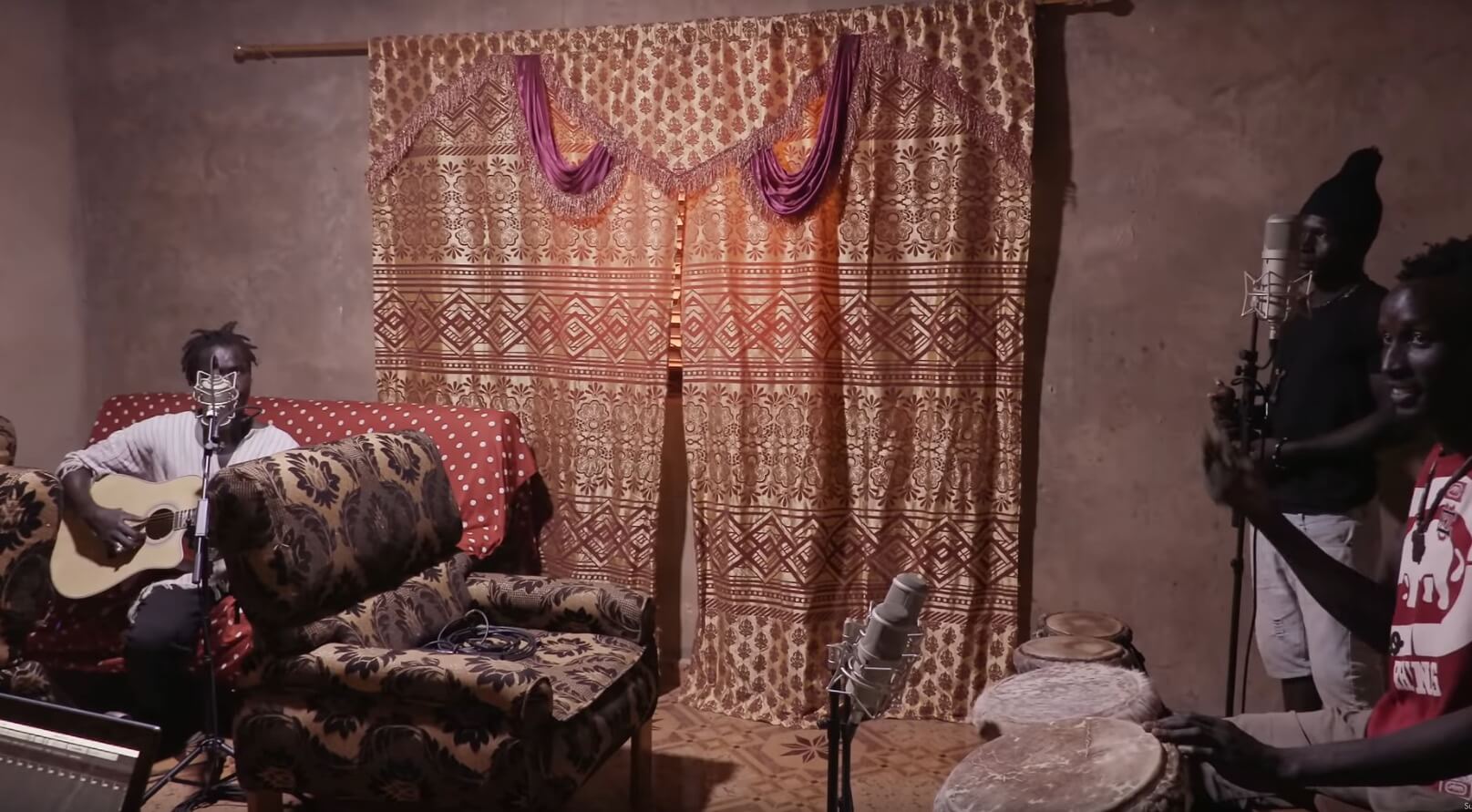
Simon & Greg placed Papice on one side of the Room surrounded with furniture, and the two percussionist/vocalists on the far end for maximum isolation.
They placed the percussionist/vocalists at the far end of the rectangular room, lengthwise. Both were close to and facing away from the short wall. Simon & Greg set up a stereo pair of Lauten Audio Clarion FC-357 mics (which are also FET large-diaphragm condensers) in front of the djembes, and an AKG D12 VR (a large-diaphragm dynamic kick drum mic) on the floor under the biggest drum to capture its low bass frequencies.
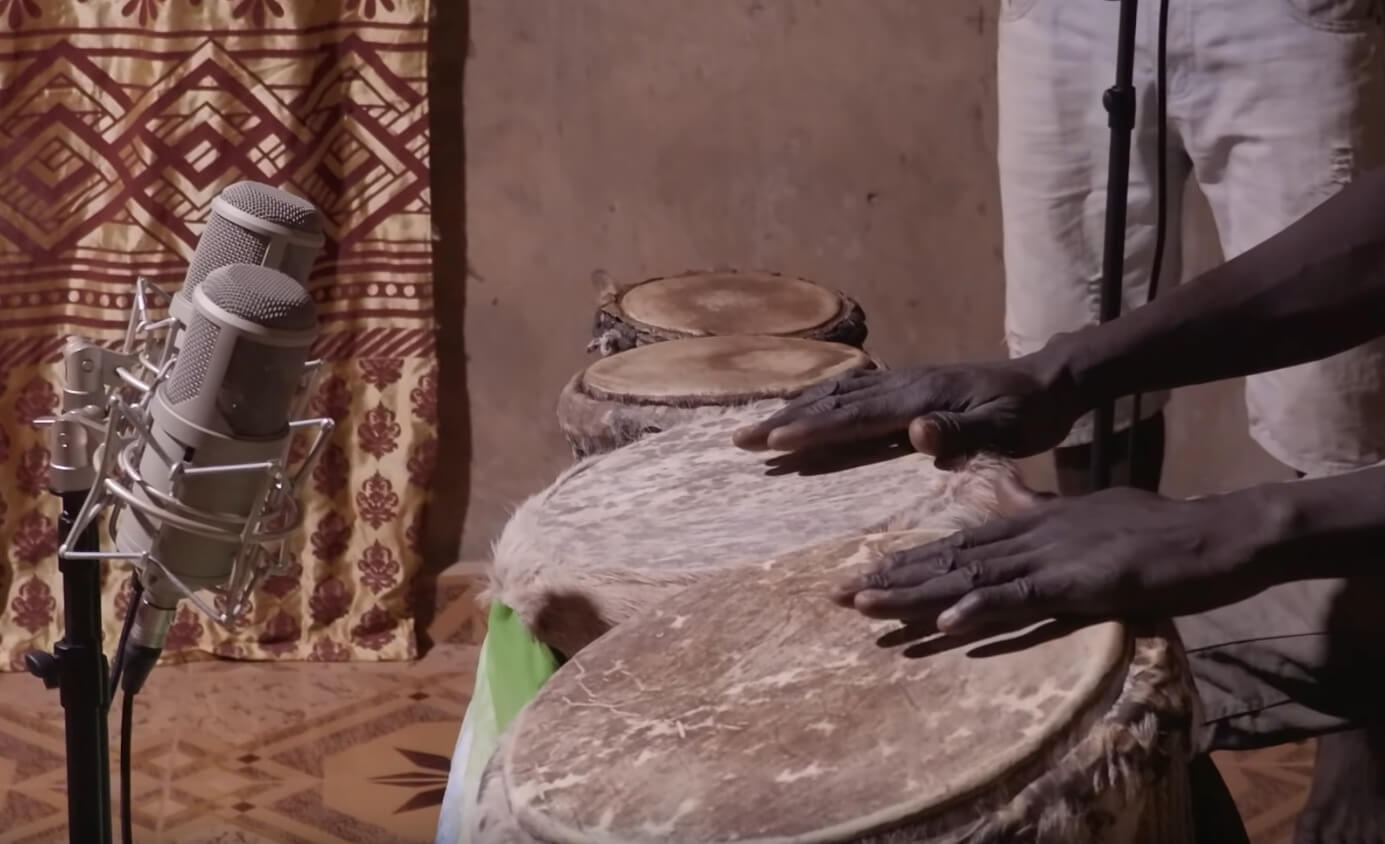
A pair of Lauten Audio Clarion FC-357 condenser mics were used in a stereo configuration to capture the sound from the djembes.
Go Figure
At this point, they needed to make a decision about how to capture the live background vocals of the two percussion players without getting a ton of leakage from the djembes. Their solution was to use the other Atlantis mic set to its figure-8 (aka "bi-directional") pattern as a sort of room mic—they referred to it as the "Back" mic.
If you're not familiar with a figure-8 pattern, it picks up evenly from the front and back of the capsule, while rejecting sounds that come from the sides. The front and back of the mic's capsule faced directly at the musicians. Because the djembes were off-axis from the back mic, they were less likely to bleed into it.
The following audio examples use the downloadable tracks from this session that are available with this episode of Simon & Greg Record the World.
Example 1: Here's what the setup sounded like on the song "Ndolly." This is the Back track only. Despite the mic placement, a fair bit of djembe did leak in, but, as you'll see in the next example, the room sound it ppicked up ended up being helpful in the mix. The background vocals come in in the middle, and you’ll hear how well they picked up from the mic’s figure-8 pattern.
Example 2: This one starts with just the left and right djembe tracks and then repeats with the mono Back track added in. The bleeding djembes on the Back track are recorded from a significantly greater distance than the dedicated mic pair. As a result, it sounds like there might be some comb filtering going on because of the phase differences. The tone of the drums is thinner with the bleed added in. That said, with the stereo pair on the djembes panned all the way left and right, adding the Back track fills out the center of the stereo image in a pleasing way.
All-Around Skills
The excerpt skips to the following day when the band was recording background vocal overdubs. Simon & Greg again came up with a useful strategy that took advantage of one of the polar patterns on their Atlantis mic. They put it in omni, meaning it would pick up equally all around, and placed the three band members—who were all singing background vocals—equidistant around three sides of the mic, which was placed next to the wall.
If there were only two singers, Simon & Greg might have considered using the figure-8 pattern again, but that would have only provided two primary positions for the singers (front and back). Because there were three singers, omni was a better choice.
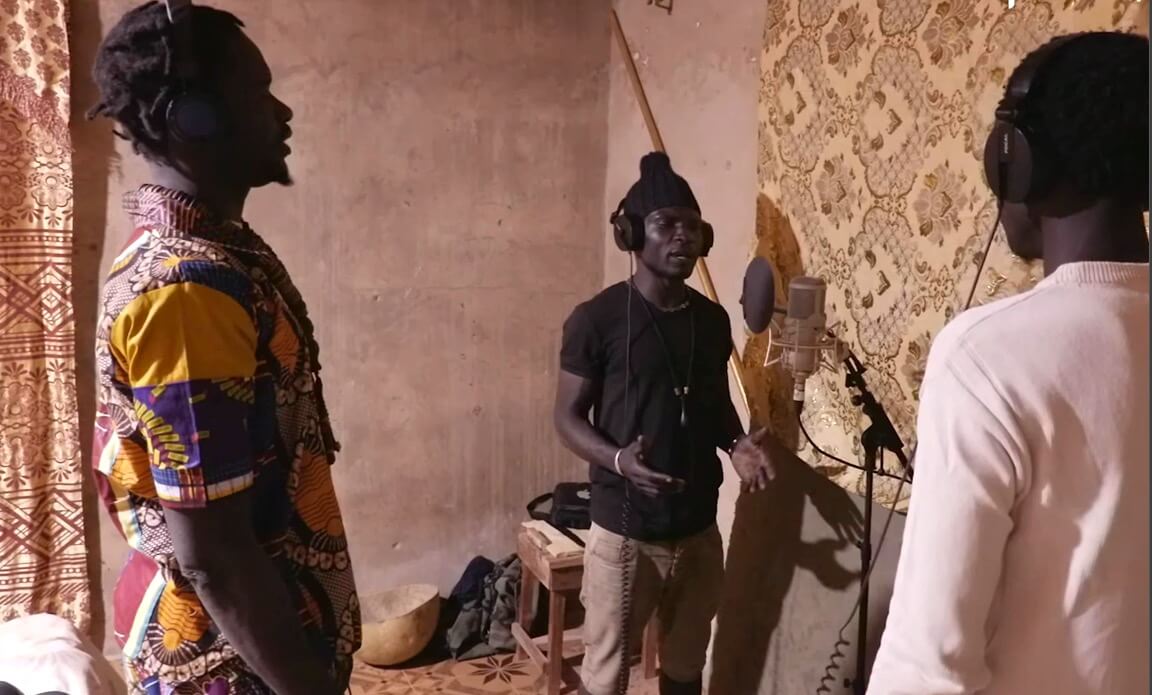
Taking advantage of the omni pickup pattern.
Another option was to use a pair of mics in a stereo configuration like XY or Blumlein to get a true stereo image, with the singers standing close together in front of the mics. But the choice of the omni pattern and doubled parts proved to be an efficient strategy.
They also could have chosen to record each singer individually, doing multiple passes of their parts and then panning them to create a stereo effect. But that would have been quite time consuming, and the singers were probably used to blending together, and may not have felt as comfortable singing the parts individually.
Looking for Rejection
Simon & Greg faced plenty of obstacles in this particular stop on their mobile recording excursion. They were tracking an ensemble (albeit only a trio) who wanted to record their songs with everyone playing together and with some of the vocals sung live. They were also working in a room they'd never been in before that first day. What's more, their gear was necessarily limited by what they could fit in a backpack.
One advantage they did possess was having two pair of quality Lauten Audio mics and two excellent interfaces (an RME 802 and a UAD Apollo Twin). Those gave them reliable options for miking and capturing clean and accurate audio.
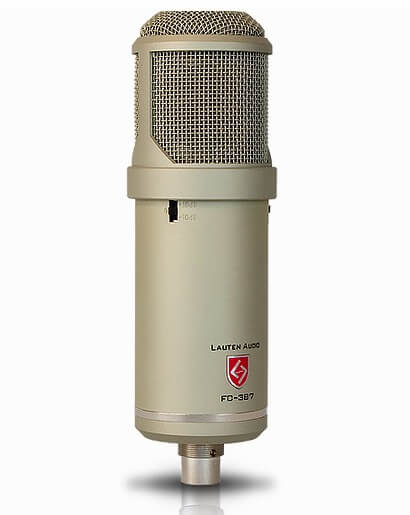
The Lauten Audio Atlantis mics carried by Simon & Greg offered not only high-quality sound but the flexibility of multiple polar patterns.
Stop the Bleeding
If you're recording an ensemble in a home studio, you'll probably face some of the same obstacles that Simon & Greg did in the video. Depending on what you're tracking, how many musicians and singers there are, and the number of inputs and quality mics you have, you may have to get creative like they did.
If you're recording a drum kit, something Simon & Greg didn't have to deal with on this session (although they did have the djembes), you'll have to figure out a way to isolate it from any other open mics, or deal with a lot of bleed, which will complicate and may hinder your mixing.
Without getting into the subject of drum miking, which is one that would require more than one blog post to cover, let's look at some of the things you can do to make your ensemble recordings in your studio more successful.
Try to isolate loud instruments like the drums in a separate room. If you don't have a cable snake to run to another room (or floor), you can double- or even triple-up on mic cables to gain length and use headphone extensions to locate the drummer somewhere away from the other open mics. If you are dealing with bleed issues, make sure you position the players in the room in a way that takes advantage of where the mics pick up and where they reject.
For instance, a cardioid pattern mic picks up from the front and rejects from the back, so try to position musicians or singers so that they're not only as far away from each other as possible, but facing opposite (and their mics are too) so that you get the maximum rejection.
Take as many sources DI as you can. An electric guitar can go DI, and you can use an amp modeling plug-in in your DAW to create its tone, or even reamp them later. Electric bass can go DI, as well.
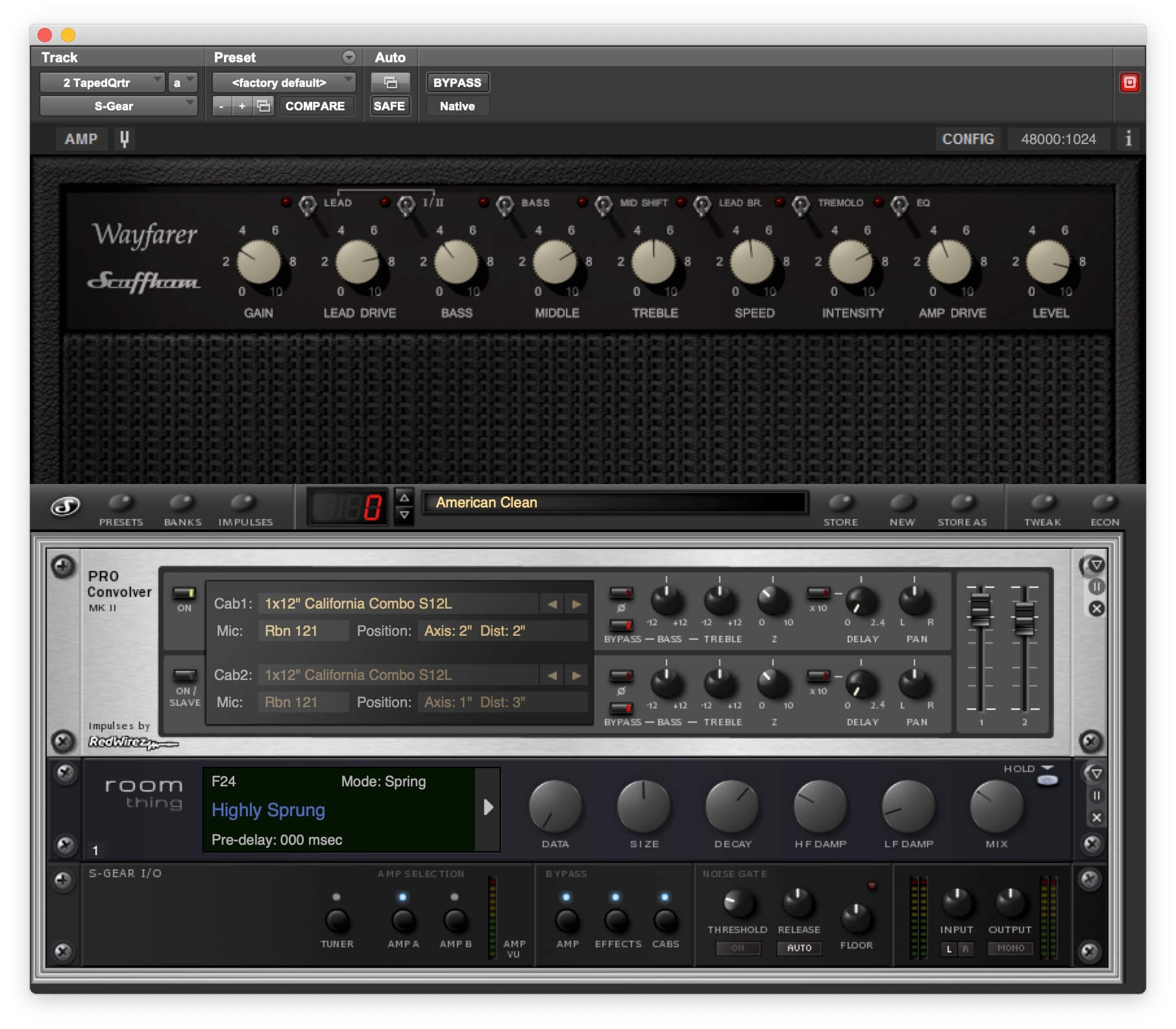
Recording guitars DI and using amp modeling software (Scuffam S-Gear is shown here) to create tone is a good way to minimize loud sources during an ensemble recording.
Unless there's an important reason to go for keeper vocals simultaneously with tracking the instruments, it's best to have the singer just sing scratch vocals. Hearing the vocals during tracking is important reference for the musicians. Otherwise, they may have trouble keeping their place. If you're recording to a click, and everyone's pretty comfortable with playing that way, you can have the singer record scratch vocals in advance, which are tracked to the click at the correct spots in the song arrangement.
Have the scratch vocal track playing in your DAW session as the musicians record. That will give everyone the reference they need, without the worry of the singer's voice bleeding into other open mics. If that's not a realistic scenario, try to isolate the singer in another room or have him or her sing the scratch vocals quietly (with the mic cranked up.)
If you think creatively and plan your session setup out in advance, you can maximize your results. Just ask yourself, "What would Simon & Greg do?”